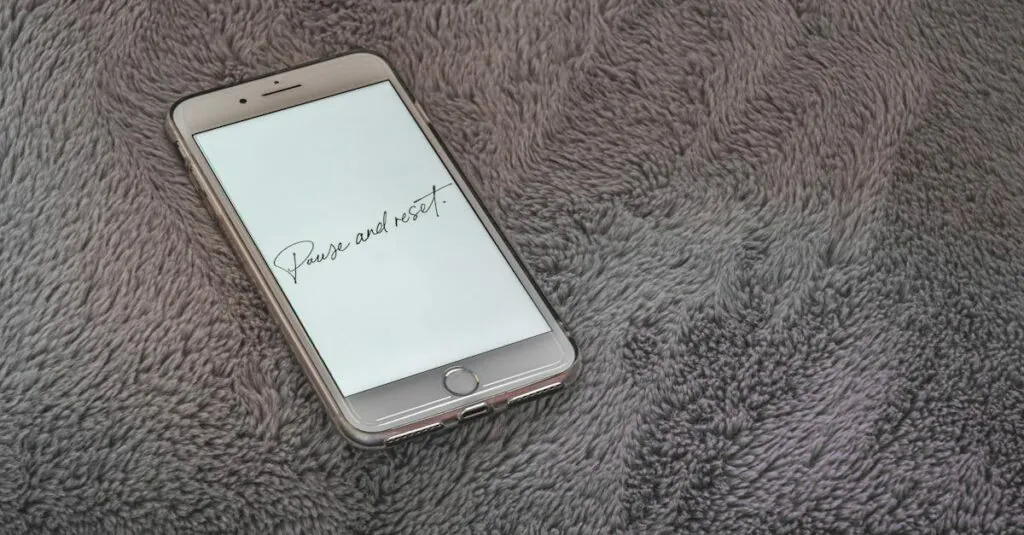Table of Contents
ToggleEver felt like your iPhone’s app is acting like a moody teenager? Slow responses and unexpected crashes can drive anyone up the wall. Fortunately, resetting the app cache could be the magic trick you need to restore order in your digital life. Think of it as giving your apps a refreshing spa day—out with the old, in with the new!
Understanding App Cache
App cache stores data temporarily to speed up processes and enhance user experience. Managing this cache is crucial for maintaining optimal app performance on an iPhone.
What Is App Cache?
App cache consists of data files that apps create to ensure quick access to frequently used information. Storing images, scripts, and preferences, cache helps applications load faster. Each installed app utilizes its own cache system to improve speed and performance without needing to fetch information from the internet repeatedly.
Why Clearing Cache Is Important
Clearing the cache prevents apps from slowing down over time. Stale or corrupted cache files may lead to crashes and freezes. By regularly resetting the cache, users can enhance their device’s performance and ensure a smoother experience. Optimizing storage space also becomes easier when cache files are deleted, freeing up valuable resources. Regular maintenance allows the system to run more efficiently and reduces potential glitches.
How to Reset App Cache on iPhone
Resetting app cache on an iPhone enhances performance and resolves various issues. Users experience fewer crashes and improved response times.
Resetting Cache for Individual Apps
Users can reset the cache for individual apps by deleting and reinstalling them. First, locate the app on the home screen. Next, press and hold the app icon until a menu appears, then select “Remove App.” After this, navigate to the App Store, search for the app, and install it again. This process helps clear the app cache effectively. Furthermore, it ensures that the app downloads the most current files, eliminating outdated data.
Using Settings to Clear Cache
The Settings app provides an option to manage cache for specific apps. From the Home screen, users should open Settings and scroll down to locate the app. Selecting the app reveals its storage details. If the app supports it, users can tap on “Clear Cache” or “Offload App.” This action removes cached data without affecting personal files. Utilizing this feature keeps apps running smoothly and optimizes storage capacity efficiently.
Alternative Methods to Free Up Space
Freeing up space on an iPhone improves functionality and enhances overall performance. In addition to resetting app caches, several alternative methods assist in optimizing storage.
Offloading Unused Apps
Offloading unused apps frees up space without permanently deleting personal data. When an app is offloaded, it remains visible on the home screen but is removed from the device. Users can initiate this process via Settings by navigating to General and selecting iPhone Storage. From there, each app shows an “Offload App” option. Confirming this choice allows the app to be removed, while personal documents remain intact. Reinstalling the app later retrieves all previous data seamlessly, assisting in managing device storage efficiently.
Deleting and Reinstalling Apps
Deleting and reinstalling apps offers a thorough method for clearing space and refreshing app performance. When an app is deleted, all associated cache files and data are removed. Accessing this option requires users to press and hold the app icon on their home screen. Selecting “Remove App” initiates the deletion. Afterward, heading to the App Store allows for easy reinstallation of the app. This process ensures that users receive the latest updates and files, creating a truly optimized experience on their device.
Tips for Managing App Cache
Managing app cache enhances performance and optimizes the iPhone experience. Users can implement a few strategies to ensure their device runs smoothly.
Regular Maintenance
Routine maintenance keeps cache from accumulating and causing issues. Users should periodically check app settings for cache management options. Accessing the iPhone’s settings, then navigating to specific apps helps in clearing the cache. Scheduling this task every month helps maintain optimal device performance. Alternatively, creating reminders for app cache resets can streamline the process for regular checks.
Best Practices for App Usage
Adopting effective app usage habits improves overall performance and reduces cache buildup. Limiting background app refresh prevents unnecessary data storage, allowing users to conserve resources. Users can disable this feature in the iPhone’s settings under General. Staying updated with the latest app versions ensures optimal functioning and efficient cache handling. Additionally, users should only download essential apps, as this limits storage usage and cache accumulation.
Resetting app cache on an iPhone is a simple yet effective way to enhance performance and resolve common issues. By regularly clearing cache data users can prevent slow responses and crashes that often disrupt their experience. Whether opting to delete and reinstall apps or using the Settings app for cache management each method provides a straightforward solution.
Incorporating these practices into routine maintenance not only optimizes storage space but also ensures that apps run smoothly. Staying proactive about cache management can lead to a more efficient and enjoyable iPhone experience. With a little attention to app performance users can keep their devices running at their best.







